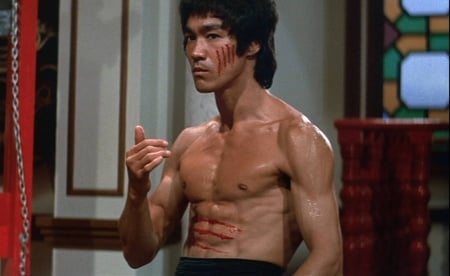Enter the Dragon is the zenith of cinematic martial arts experiences, and has been since its release back in 1973. Among fans, it is revered as the feature which legitimised the martial arts genre for Western audiences and brought the very capable Bruce Lee into the global spotlight. Bruce Lee's name has become synonymous with martial arts cinema, and the man - who tragically died at the age of 32 - has achieved an almost mythical status since his untimely demise. Prior to Enter the Dragon, Lee was only known to martial arts fans or to those who saw him in The Green Hornet on television, but Enter the Dragon was the one that broke him into the big time. Alas, before the film had even premiered, he was dead. Fortunately, all these years on, Enter the Dragon is not just a historical curiosity but a highly watchable, enjoyable action commodity. It may not have the slick special effects of Crouching Tiger, Hidden Dragon or the Kill Bill films, but Lee and his co-stars more than compensated for this in charm and stunning action sequences of boundless grace.

Like most action films, the plot is very simple and uncomplicated. A Shaolin master known as Lee (played by Lee) is approached by law enforcement officers to infiltrate a fighting tournament on an island run by a gangster named Han (Shih). Han is a renegade Shaolin monk who has a lucrative business in slave trade and opium dealing. As a result, he has disgraced his and Lee's temple with his heinous behaviour. Additionally, Han forced the suicide of Lee's sister, so Lee has a double motive for revenge. Thus, Lee is sent to the tournament to uncover evidence against Han in order for the authorities to come in and arrest him.
To say the least, the story itself is not much to brag about. The novelty of the deadly tournament (a concept which served as inspiration for countless video games and movies) peters out before the halfway point, as only a small amount of fighting in the arena is actually shown. Like many action pictures of the late '60s and early '70s, Enter the Dragon borrows heavily from the James Bond franchise. For the most part, the film is a spy thriller with palpable echoes of Bond as Lee carries out his investigating. The climax, too, is highly Bond-esque. Meanwhile, Han carries a fluffy white cat and surrounds himself with lethal female bodyguards. Yet, the undeniable similarities to the Bond franchise do more than increase the film's appeal for a Western audience - the contrast between Lee and 007 additionally provides a useful vehicle for illustrating the intrinsic similarities and differences between Chinese and Western culture.

Obviously, Enter the Dragon is not a profound drama of human emotion and romance. However, it is chock full of great action, all of which was choreographed by Bruce Lee himself. Decades on, Lee is still regarded as one of the world's greatest martial arts choreographers, and the reason for his enduring reputation is obvious while watching Enter the Dragon. Lee was a master of his craft; an immaculately-honed machine whose lightning-fast and beautifully choreographed fight scenes remain both exciting and visceral. Not only are these some of the best martial arts sequences you will ever see, but they were also executed without the aid of wires or modern digital effects, which makes them all the more impressive. In addition to crafting excellent fights, Lee worked tirelessly as an ambassador for Chinese culture. He aimed to bring the elegance and philosophy of Asia to audiences around the world. Unfortunately, though, during the time between Lee's death and the premiere of Enter the Dragon, the film was trimmed down to remove some of the more philosophical elements which Bruce had campaigned to include.
In terms of acting, it's hard to deny that Enter the Dragon is rather B-grade. The acting is passable but unspectacular, and - typical for martial arts pictures of the period - the ADR work and dubbing is at times atrocious (the film was shot without sound). The standout of the cast is Bruce Lee, whose screen presence is electrifying and who delivered a measured, understated performance. It's easy to see why Lee was such a big star - he had a charm and charisma that few actors have. John Saxon (A Nightmare on Elm Street) - the only 'recognised' Hollywood actor in the bunch - is passable as Roper, while Jim Kelly (Black Samurai) reeks of blaxploitation. The film even features Jackie Chan, in a blink-and-you'll-miss-him cameo appearance (he plays a henchman who's killed by Bruce Lee). The rest of the cast is composed of martial artists and actors from Hong Kong, and they're undeniably second-rate. Their performances are hidden below the mask of the aforementioned awful dubbing.

While Enter the Dragon is a perfectly enjoyable action film, it's still flawed - the cartoonish sound effects are unintentionally laughable, the cinematic techniques have dated, and dialogue is definitely not a strong suit. Also, if boiled down to its basic constituents, it's an unspectacular action film that's marred by the usual genre trappings but benefits from the spectacular talents of Bruce Lee. Thus, Enter the Dragon is not so much a masterpiece as it is enjoyable and influential.
7.6/10
 Login
Login